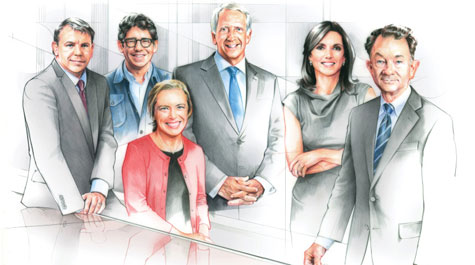Bright Lights, Big Apple
The following story originally appeared in the summer 2016 issue of the W&M Alumni Magazine - Ed.
Inspiring Leadership, From the Crim Dell to the Brooklyn Bridge and Beyond
To walk the streets of modern New York City is to know something about Athens or Rome, Constantinople in their gilded heydays. If you look hard, you can find the remnants: a domed ceiling replete with stars and a statue of the wing-helmeted Mercury holding sentinel — the god of commerce and transportation, the art of the swindle and the art of letters. Like the fleet-footed marble god, the city that never sleeps is a cultural Rorschach, heralded by many and reviled by some. Home to Broadway and Wall Street, boardrooms and street food, NYC prides itself on being a beacon to the free world and a hub for many of its brightest leaders. Flocks of tour guides with photos of skyscrapers obstruct the view, promising to take you to the top.
But you wave them off. You know where you’re going.
From Grand Central, it’s a short hike up the blocks to Rockefeller Center, home to Radio City Music Hall and its high-kicking Rockettes. It’s where tourists go to explore storied television studios and where young children and old lovers go to skate slick orbits in winter beneath a statue of Prometheus and a Norway spruce shooting up a hundred feet into the air.

And it is where Beth Comstock ’82, vice chair of General Electric, came to hone the craft of marketing after stints with CBS and Turner Broadcasting, ascending quickly to the role of president of integrated media at NBC Universal before GE sold off its majority share to Comcast (or “Kabletown,” if “30 Rock”’s Liz Lemon is to be believed). Perennially ranked as one of the top 50 “Most Powerful Women in the World” by Forbes, Comstock is the first woman to serve as vice chair in General Electric’s 124-year history. When you achieve a first within a company that started with Edison’s light bulb, suffice it to say, you’ve done something.
Comstock oversees GE Business Innovations and sums up the far-reaching company best. “We’re sort of at the intersection of industrial and digital and where the world’s going there,” she says. “We’re about infrastructure, advanced technology. My company’s about making healthcare more accessible, it’s about new forms of energy, it’s about taking people to places safely, and it’s about being an engine of progress for the world. Most of the people who work at GE are very mission-based. They want to be part of saving lives and improving health care. They love the quest of flight in the aviation business, and they’re passionate about energy and getting access to energy in parts of the world where they don’t have electricity. Those kinds of things that, I think, keep people excited.”
In a recent showcase of advanced engineering, GE innovators traveled to an old foundry to submerge a snowball into 2,000-degree molten metal, challenging the old idiom about having a “snowball’s chance in hell.” With the help of a GE-designed case, the snowball survived, ascending from the metal ice-cold. But of course GE’s innovations have real-world applications that go well beyond tongue-in-cheek tinkering.
“I think this idea of what it means to be a digital industrial company is very exciting,” Comstock says. “In bringing the Internet to industry, we have the ability to connect every piece of machinery — a jet engine, a wind turbine. But why would you want to do that? Because over time you can start to predict when things are going to happen and make companies more efficient. Machines aren’t going to have to stop for maintenance before they’re ready. Planes will keep flying when they don’t need to be serviced. And on the other side, if something’s going to go wrong, you’re going to be able to predict it before it happens.”
Comstock’s position in business is a tall order for anyone, much less a self-described “small-town Virginia girl” who came to William & Mary as a biology major — a field far removed from international commerce. “I never expected biology to play out in my marketing and business career,” she says, “but biology’s taught me a lot about ecosystems and the way the world collaborates. For any system to work well, each thing has to have its role, and one depends on the other. It’s good to be reminded of that in business. As I go forward, I find the classes I had in anthropology to be incredibly relevant in business. I wish I’d had more philosophy as we’re living in a society filled with new data challenges and unintended consequences of new data. I’m finding those historical and philosophical insights would probably give you a framework at least to think about how similar issues were handled in the past.” In truth, Comstock is the sort of person you can imagine deciphering Plato while taking a power walk through Central Park. She is the epitome of smart leadership, a quality that seems to evolve like any other body in motion.
“Often we forget that leadership is about people,” Comstock says. “The idea of managing people? That notion’s going away. It’s about people coming together, collaborating with a shared sense of purpose, treating people how you would like to be treated, understanding that there has to be a compass to the work that you’re doing.” Altruism, of course, perplexed Darwin. It would take years for scientists to correlate “survival of the fittest” with evolutionary advantage, the benefits of a collaborative unselfishness as seen within a group. Altruistic leadership seems to come to Comstock naturally.
“I love trying to crack the riddle of what’s potentially a disruptor, or a new force that we can use to make how we work better. There’s always a new model to understanding what’s next. That’s what’s kept me going forward in this area. I love the discovery of it. Sometimes I secretly wish I’d have been an anthropologist,” she says. “And maybe in some ways I’ve gotten to do that through marketing, which is really about the study of behavior.”
After a short hike back, we take the 7 Train from the subterranean belly of Grand Central, beneath the swell and chop of the East River into greater Queens, dropping down by way of the G into the Brooklyn community of Greenpoint. Once home to a shipyard and a decaying assemblage of factories, Greenpoint now pulses with the renewed beat of youth. It is where musicians practice their ballads and where coffeehouse poets tremble before microphones. Even the graffiti artists hold a learned pedigree, as evidenced by the occasional Banksy. Greenpoint is also the home of Kickstarter, perhaps the world’s most recognizable online crowdfunding platform. Housed in the former shell of a pencil factory, Kickstarter is a favorite among creative types, with backers supporting over 100,000 projects since the company’s inception.
Of all the CEOs of well-known American companies, Kickstarter’s Yancey Strickler ’00 is in many ways the most unlikely. A self-described “reluctant business
person,” Strickler was raised on a farm in Appalachian Virginia, the son of a traveling waterbed salesman who aspired to make it as a country music artist. This love for harmonies rubbed off on the junior Strickler, who began to carve out a life as a journalist and music critic during his time at William & Mary. Not that college life always suited him. “When people are doing one thing, I want to do the opposite,” Strickler laughs. “I think college was hard for me for that reason.”
But as liberal arts colleges owe a great debt to the thought of the Greeks, one instantly recognizes in Strickler the wisdom of the old maxim carved into the Temple at Delphi: Know thyself. While many of his classmates immersed themselves into the more social aspects of campus life, Strickler worked as music director for WCWM, the student-run radio station. He traded music with English professor and former Spiral Jetty frontman Adam Potkay and credits author and Vanity Fair contributor Sam Kashner for helping him make the move to New York City. And while Strickler embarked on a blossoming career as a journalist and editor — writing for noted periodicals such as The Village Voice, New York magazine, and Pitchfork — it was a chance meeting with cofounder Perry Chen that would eventually thrust Strickler into the world of crowdfunding.
Chen was an artist, Strickler was a writer, and third cofounder Charles Adler was a designer. Looking around the New York art scene, it was easy to find a flaw in the system’s design. “In a more traditional model,” Strickler explains, “the only ideas that get through are those that have the potential to be profitable to someone else. On Kickstarter, we very consciously wanted to create a world in which ideas are supported because someone decided they were cool and worth doing.” To date, some of those ideas have been very “cool.” Backers have supported an Oscar-winning film, 11 Oscar-nominated pictures, and 15 Grammy-nominated projects among Kickstarter’s other accolades.
In an age in which hip young founders of promising startups are known to sell big — and quickly — the veritable starving artists did a very curious thing: the trio decided to make Kickstarter a public benefit corporation, which legally bound them to “do good” and to perform a public service. As Strickler puts it, “Business and commerce can be more balanced and bound to what society needs rather than just the maximization of money. In one of his last essays, Adam Smith, the father of the free market, argued that altruism — and not self-interest — is the primary motivator of humanity. The current economic model is lucrative for some but completely destructive to others. I’m interested in a more diverse set of systems. Kickstarter’s system wouldn’t work for Goldman Sachs, but there are other models beyond just maximizing returns — and a lot of those models have the potential to be healthier.”
Like Comstock, Strickler seems to have gained something by way of his unlikely route. “There are some ways in which I see being a writer and being an entrepreneur as being quite similar,” he says. “You’re basically trying to shape a world in both cases. In the world of writing, you’re shaping and measuring a world through verbs and syntax and storytelling, while in the other you’re shaping through people and systems and another kind of storytelling.”
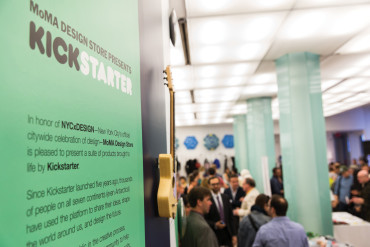
We leave Greenpoint the way we came, eventually hopping back off the 7 and cutting a sharp left out the Grand Central doors, taking a leisurely stroll across the avenues past the Chrysler Building, resplendent as any art deco megalith. We bebop past news stands blaring about the economy and healthcare and global warming while a fire truck with sidewise ladders screams angrily down the streets. We cut south after a spell to arrive at NYU Langone Medical Center’s Concussion Center, home to some of the world’s brightest physicians. The list includes the Department of Neurology’s Vice Chair, Dr. Laura Balcer ’87. As a neuro-ophthalmologist, Balcer has a job that most of us cannot spell, much less immediately understand.
“A neuro-opthalmologist is either a neurologist or ophthalmologist who specializes in how the eyes and the brain connect,” Balcer explains. “And really the eyes are a part of the brain, so we look at the effects of concussions or conditions such as multiple sclerosis (MS), both of which affect the eyes and the brain and can give you double vision, trouble seeing, or trouble with the eyes working as a team.”
Balcer, a Gamma Phi Beta sister, fondly recalls studying jellyfish at William & Mary under the tutelage of Dr. Robert Black, who stressed that while there was “certainly a need for academic productivity,” a scientist’s work “should be balanced with the need to have something that you know is accurate, that you believe in, and that you love to work on.”
Dr. Balcer found that love and productivity as a resident at the University of Pennsylvania, shortly after being graduated from Johns Hopkins Medical School. Her residency paired her with Dr. Steven Galetta, a mentor and now longtime friend who serves as her department’s chairperson. “The thing that really attracted me to neuro-opthalmology was how much fun the mentors seemed to be having,” Balcer recalls. “One of the great surprises in my career is how early you become a mentor. It’s humbling that the younger students are looking to you — students, trainees, junior assistant professors. There are aspects in how you are taught that stick with you and teach you that it’s not just about the tangible products. It’s about how to navigate, how to think about science and medicine and academics. It’s about the social aspects of medicine, how to treat your patients and colleagues.”
A dedicated cook in her off-hours who loves to dabble with spices and measuring spoons to perfect her recipes, Balcer divides her work time between her practice, her teaching and, of course, her research. Her vast studies on eye structures and the use of optical coherence tomography to observe disease mechanisms earned Balcer — along with colleagues Peter Calabresi and Elliot Frohman — the distinguished Barancik Prize for Innovation in MS Research in 2015. Balcer credits the team approach. “Seeing outside of one point of view, seeing the bigger global picture is a great challenge no matter what field you’re in,” she says. “At NYU Langone, our promotions committee has worked hard to reward people for collaborative work because no one can do as much as a great team.” And if that sounds too wide-eyed, the proof is in the pudding. Balcer and her colleagues have extended their research to study concussions, an emerging hot topic among sports fans who are just getting keyed in to the long-term debilitating effects of concussions and other traumatic brain injuries. Headlines are increasingly peppered with stories of oft-concussed athletes engaging in everything from errant behavior to suicide, and the Center for Disease Control estimates that over 5.3 million Americans are living with the effects of traumatic brain injury-related disabilities on a daily basis — many stemming from their sports days in high school. Balcer and her colleagues have been working with the Pelham Youth Hockey Association to study and develop sideline tests that can better utilize the field of vision to diagnose concussions with greater accuracy.
“Just like MS needed a visual measure in its field, so did concussions,” she explains. “Vision is a huge part of concussions. We feel as if we’ve had a role in introducing vision to the concussion world, which really does our hearts good because it’s a big part of the brain. It’s greater than 50 percent of the brain’s pathways.” Just as altruism stumped Darwin, he was also confounded by the mystery and complexity of the human eye, listing it in On The Origins of Species under the subheading “Organs of Extreme Perfection and Complication.” That same complexity gives Balcer reasons to be hopeful as the unique properties of the eye offer insights on the body’s greater neural workings. “In neurology,” she explains, “we would like to work toward using vision treatments that repair the nervous system. If we could repair the spinal cord in MS and the brain in concussions, our team would be really proud to contribute to that breakthrough and the possibilities it offers.”
We make the hike back to the 7 to check out the new subway stop that has been built for Hudson Yards on the Far West Side. Billed as “the largest private real estate development in the history of the United States,” Hudson Yards is the site of a 17-million-square-foot mixed-use development with a one-million-square-foot retail center that is headed by Ken Himmel ’68, CEO of Related Urban. Himmel is no stranger to large-scale projects within the city. The Time Warner Center, which kisses the hem of Central Park at Columbus Circle, is another one of his team’s better-known developments, along with marquee national locales such as CityPlace in West Palm Beach, Water Tower Place in Chicago, and Pacific Place in Seattle. His broad real estate empire stretches into Abu Dhabi, and his many restaurants include Grill 23 & Bar, one of Boston’s most highly regarded eateries.
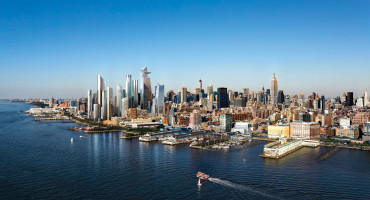 Himmel began his love affair with the hospitality industry while working for the Salem Country Club as a sophomore in high school. By the time he arrived at William & Mary, the New England native had shifted his focus to premed studies. “I discovered that my personality didn’t lend itself very well to spending all day in a laboratory,” Himmel laughs. “I think my wife would say that my bedside manner wasn’t up to the task.” Despite Himmel’s objections, the chief executive and hospitality guru comes off as chiefly hospitable, proud of his broad liberal arts education. “The diversity of the program was phenomenal,” he says. “It provided the sort of broad education that unfortunately a lot of kids don’t get today. In Williamsburg, you really do hunker down and study.”
Himmel began his love affair with the hospitality industry while working for the Salem Country Club as a sophomore in high school. By the time he arrived at William & Mary, the New England native had shifted his focus to premed studies. “I discovered that my personality didn’t lend itself very well to spending all day in a laboratory,” Himmel laughs. “I think my wife would say that my bedside manner wasn’t up to the task.” Despite Himmel’s objections, the chief executive and hospitality guru comes off as chiefly hospitable, proud of his broad liberal arts education. “The diversity of the program was phenomenal,” he says. “It provided the sort of broad education that unfortunately a lot of kids don’t get today. In Williamsburg, you really do hunker down and study.”
Himmel, who eventually got his degree in psychology before going to Cornell for hospitality, got his big break when he was named the managing director of development of the Ritz-Carlton Hotel at Water Tower Place in Chicago. “I made sure I was given an opportunity to work on that project,” he says, “which was sort of the pacesetter of my career because it was mixed-use, contained vertical retail and was well-
located on Michigan Avenue. This was 1975, before anyone knew what ‘mixed use’ meant. I was just 29 years old, but no one was afraid to give young people enormous amounts of authority and responsibility then. There was certainly a lesson to be learned and it has guided our culture at Related and how we grow young talent.”
It is said that the devil is in the details, but one wonders if Ken Himmel arrived there first. A prime example: One of his employees flies from San Diego to Fresno every Sunday to handpick the cattle that will be served at Grill 23 & Bar. “The ability to lead and drive a business comes from the respect of the people below you and your knowledge of the business you’re driving, and that really comes from digging into the granular details,” Himmel says. “If I showed you the Hudson Yards retail plans, there are literally a thousand pages that represent that project today. I didn’t draw every one of those pages, but I can tell you I have focused on every detail in those drawings.”
A lot of that attention to detail goes into training and building the right team. “One of the things to recognize here is the teamwork and the collaborative effort that is required on both the technical and creative sides of the business,” he says. “The greatest challenge we have in the digital age is how to create destinations and experiences that will draw you out of your home. Fewer and fewer people are making the decision to leave their homes and go to a physical shopping destination. And that’s why when we put these projects together in these incredible locations in our great cities, we spend so much time on programming and merchandising and finding unique venues and platforms that draw you into the project. I could make this sort of overarching statement about projects, both here and around the world, but it starts with the right people. The results are extraordinary if you get the right team.”
From Hudson Yards we make the walk to the 1 Train, speeding beneath the Garment District to pop out about a block from the Ambassador Theatre, home to “Chicago.” The musical is one of many that have been blessed by the hands of costume designer William Ivey Long ’69, L.H.D. ’04, winner of six Tony Awards for his craft. Designer to over 60 Broadway shows, including hit productions such as “The Producers,” “Chicago,” “Hairspray,” “Nine,” “Cabaret,” and “Cinderella” — and many more television, film, and off-Broadway performances — Long is a staple in an industry that does over $13 billion annually in NYC alone. For the past four years, Long has also served as the chairman of the American Theatre Wing, the almost century-old service organization “dedicated to supporting excellence and education in theatre.” The group also sponsors the Tony Awards, something Long knows intimately, having been nominated for 15.
“I grew up in an academic theatric household,” Long explains. “My parents taught theater for Winthrop University in South Carolina, among other places. It really was the family business, though I didn’t expect to go into it. I studied history at William & Mary and art history at Chapel Hill. It was only at my third college, Yale, where I went to drama school, where I actually focused on design — and it was scenic design. The costume design only came into focus once I came to New York.” A tireless learner, Long was the quintessential Renaissance man while an undergraduate, studying painting and European history, while his thesis was on Proust. Long values his wide-ranging education. “My math classes were important,” he says. “It was important that I dissected a fetal pig. The more you know about the world, the more you know about everything — and the more you know about people.”
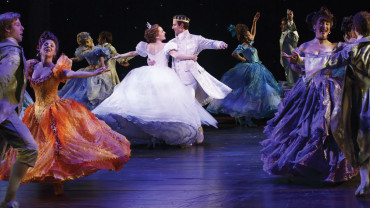 Despite his broad knowledge of cuts and fabrics, psychology is clearly an under-acknowledged aspect of his craft. “The business of costume design, I often say, is helping people become somebody else. Is the story supposed to be a discovery for the audience in terms of who this character is? Is the audience supposed to know all along and then be surprised — or think they know all along? In other words, is it a hidden character trait that you want to support, or is it just face value in sort of a flat way? It’s usually not that, by the way. The clothing is about getting into the brain of who this character is, but it’s also about getting inside the brain of the actor who is becoming this character and what they need psychologically.”
Despite his broad knowledge of cuts and fabrics, psychology is clearly an under-acknowledged aspect of his craft. “The business of costume design, I often say, is helping people become somebody else. Is the story supposed to be a discovery for the audience in terms of who this character is? Is the audience supposed to know all along and then be surprised — or think they know all along? In other words, is it a hidden character trait that you want to support, or is it just face value in sort of a flat way? It’s usually not that, by the way. The clothing is about getting into the brain of who this character is, but it’s also about getting inside the brain of the actor who is becoming this character and what they need psychologically.”
While casual outsiders tend to romanticize costume designers, imagining frazzled Mad Hatters with tape measures in tow, the business side is vital to Long’s work. Up by 5 a.m. to make sketches and answer emails, Long has mastered balancing the creative side of his job with the organizational skills and business savvy required of any high-level manager. “You don’t just design something,” Long laughs. “In fact, it’s almost a misnomer. It looks very glamorous on TV. Throwing chiffon in the air is one of the images that people have. I technically use pen and ink and watercolor and brush and oil — I use art supplies in the making of our work — but that is a miniscule part of making art. The rest is about organizing, managing, keeping the overview front-and-center at all times. We work on at least a dozen shows at one time, in various stages of completion. At the end of the day, I’m a contractor. It’s just like building a house. I draw the plans and then find the people to execute them. And then I have to watch them and check to ensure we’re on time and on budget.” But just because his work is over-romanticized, that’s not to say that Long doesn’t believe in the romance behind what he does and the people he works with. “We, maybe as much as anyone, understand wild swings of good and evil, tragedy and celebration,” he says. “We explore and celebrate the human condition in all of its various forms. History is still my relaxation. The more you study the creative works of people through the ages, the more you learn that people are all the same — and somehow surprisingly different.”
After leaving the Theater District, we immediately find ourselves walking south into the heart of Times Square, lit up in LEDs and neon. Visited by over 50 million tourists per year, Times Square is rich in costumed Elmos and naked cowboys, wide-eyed guests snapping pictures while solicitors shout something about comedy shows. A fair passel of the world population watches the ball drop on New Years’ Eve every year, many of them having grown up watching Dick Clark count down from 10 with his smooth voice and earmuffs. Todd Boehly ’96 could tell you something about the logistics. After 15 years with Guggenheim Partners — a world leader in financial services with over $240 billion in assets under management — Boehly stepped down as president in January to focus his energies into his other holdings, including prime media assets such as Dick Clark Productions, Billboard, and Hollywood Reporter. In addition to being one of the five primary partners of the Los Angeles Dodgers and co-owner of the real estate company Cain Hoy, Boehly is also chairman and CEO of Eldridge Industries, “a holding company that owns, acquires, and operates a variety of private businesses” while making use of Boehly’s vast investment knowledge. While that partial résumé sounds high-minded in the extreme, I can tell you that a writer can interview a hundred people over the course of countless hours without being asked about his day. Todd Boehly is the sort of person who will ask you about your day while listening thoughtfully to the answers. Boehly remembers his own start in New York, looking up at his six-story walkup. “‘Wow, look at this place,’ I thought. I used to wonder, ‘How does the sewer system work given all these people?’ and ‘How does the plumbing actually work?’ It’s an amazing, energetic place.”
While finance is clearly Boehly’s passion, his attention to people sets him apart. “One of the things I believe in very much is making sure that people get recognition and find rewards beyond just the financial,” he says. “A lot of leadership positions are rewarded chiefly by financials. Richard Branson said it very well: ‘Train people well enough so they can leave, treat them well enough so they don’t want to.’ Between a combination of education and recognition — if you’re arming people with those two things — then you are going to be extremely competitive as a leader because both of those things are underrepresented in most of the environments out there.”
Boehly credits William & Mary for being his first exposure to leadership and finance. He arrived at the College with an eye toward being a doctor or a philosopher, but he was instantly taken by the modeling exercises and different studies on businesses he was asked to do in his finance class. “My professors put me in a position to enjoy school because it wasn’t all hypothetical and could be applied in the real world,” he says. “It was a big moment for me. It helped me engage and enjoy academics more than I had at any other point.” Boehly joined Lambda Chi Alpha and met his wife, Katie ’95. The couple would later give back to the university by funding the creation of the Boehly Center for Excellence in Finance.
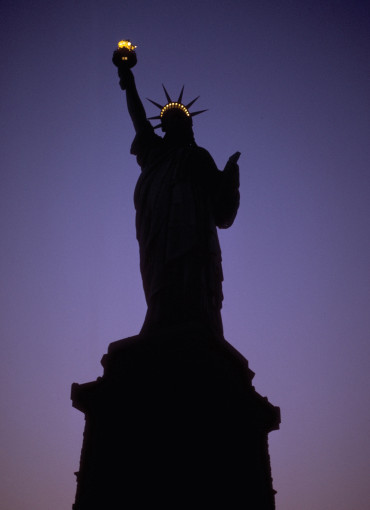 “One of the things I’m focused on with the finance center is figuring out how to take real-world problems and apply them to an academic environment to try to develop solutions,” he explains. “Some of the biggest issues are the conversations that aren’t being had. If you look at where debt balances are in the U.S., you have to wonder if the country is in the position to withstand massive interest rate rises. Trying to figure out how to brainstorm and solve the biggest problems in the world with William & Mary’s support is a win-win because you have college students who are extremely well-placed to study these real-world examples. The professionals have chores every day and can’t divert time to these sorts of things, as much as they’d love to. Setting them up in William & Mary’s environment is ideal because they have the chance to think and work on these problems while gaining some necessary expertise since problem-solving is the biggest skill out there.” For his part, Boehly is happy to provide an ear. “The value in any conversation is really all in the listening. I spend a lot of time listening.”
“One of the things I’m focused on with the finance center is figuring out how to take real-world problems and apply them to an academic environment to try to develop solutions,” he explains. “Some of the biggest issues are the conversations that aren’t being had. If you look at where debt balances are in the U.S., you have to wonder if the country is in the position to withstand massive interest rate rises. Trying to figure out how to brainstorm and solve the biggest problems in the world with William & Mary’s support is a win-win because you have college students who are extremely well-placed to study these real-world examples. The professionals have chores every day and can’t divert time to these sorts of things, as much as they’d love to. Setting them up in William & Mary’s environment is ideal because they have the chance to think and work on these problems while gaining some necessary expertise since problem-solving is the biggest skill out there.” For his part, Boehly is happy to provide an ear. “The value in any conversation is really all in the listening. I spend a lot of time listening.”
New York City, 2016. A city of over eight million people swelling by the hour, moving and evolving at thought’s speed in the manner of well-dressed, itinerant bees. They move anonymously with their fears and hopes, racked by political concerns and financial burdens and rising sea tides that threaten to capsize Manhattan into the Atlantic, not unlike an isle of myth. Sometimes we question the value of a liberal arts education. Sometimes we look at crumbling political systems and ecosystems and faulty systems of human thought and wonder if there is anyone who can light the way. But there is a reason that grand statue in the harbor, that one calling out to the tired and the poor and the huddled masses, carries her tablet and lifts aloft a 225-ton torch. That light from the sympathizing French represents an inheritance being passed from the disparate systems of enlightened Europe and Africa and greater Asia, a harmony passed from parent to child and teacher to student, embodied in the works of the grand luminaries who came before.
The Greek mathematician Pythagoras began by teaching his students the concept of the monad, a unit of one that contained within it the many. And from there he taught the dyad, two points indivisible by merit of a common thread — the way a tragic hero’s strength may hint at a fatal flaw or the way two diametrically charged particles can strike a spark to light a bulb. And from there he conceived of a harmony in which musical scales mirrored not only planets but vowels and the greater chain of evolving bodies. And this measured harmony has something to do with why Plato tells us that the final thing we learn to intellectualize is goodness.
So as Yancey Strickler retires from his day to watch basketball with his wife and young son, there is hope that his Kickstarter will add beauty to this world through a book or a song, a theatrical production all in lights. And as Beth Comstock moves anonymously across Central Park, there is hope her understanding of forms will manifest in energy connections and healthcare solutions, a better way to light a bulb. And as Laura Balcer takes that bulb to shine a pen light into the eye of a weary patient, there is reason to believe that light will shine beyond that treatment to guide her students and colleagues as they follow in her careful steps. And while Ken Himmel double-checks the schematics on the lighting for Hudson Yards, his attention to detail is being eyed by a new generation that benefits from his years of hospitable experience. Todd Boehly may cheer loudly as an electric ball drops or as a Dodger batter sends a home run into the lights, but he will also listen quietly and attentively as the Boehly Center educates the sort of young minds that will better illuminate the globe. And William Ivey Long, of course, will continue to create costumes that glint of history and of story, because sometimes the people need to dance. Sometimes in New York, as we stare up at our six-story walkup, the lesson seems to be that victory is in the dog-eat-dog flight to the top of the ladder. But the lesson — if these leaders are any proof — is that the measured guide we trust most for any steep ascent is almost always the one who will reach down a hand and take us with them.
 Skip to main content
Skip to main content

